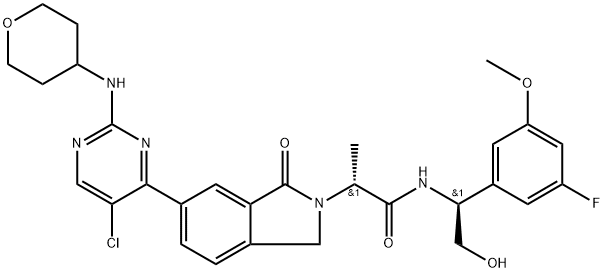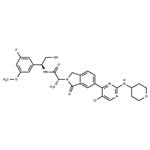ASTX-029 is a highly potent and selective dual-mechanism ERK inhibitor discovered using fragment-based drug design. Because of its distinctive ERK-binding mode, ASTX-029 inhibits both ERK catalytic activity and the phosphorylation of ERK itself by MEK despite not directly inhibiting MEK activity. This dual mechanism was demonstrated in cell-free systems, cell lines and xenograft tumor tissue, where the phosphorylation of both ERK and its substrate, ribosomal S6 kinase (RSK), were modulated on treatment with ASTX-029. Markers of sensitivity were highlighted in a large cell panel, where ASTX-029 preferentially inhibited the proliferation of MAPK-activated cell lines, including those with BRAF or RAS mutations[1].
ASTX-029 is an orally bioavailable extracellular signal-regulated kinase 1/2 (ERK1/2) inhibitor. ASTX029 has the potential to potentially enhance anti-tumour activity in a wide range of tumour types, either as a single agent or in combination with other therapies. ASTX029 is currently in clinical studies for the treatment of relapsed/refractory solid tumours, including non-small cell lung cancer, melanoma, pancreatic cancer and colorectal cancer. Especially in KRAS-mutated NSCLC.
In vivo, significant antitumor activity was observed in MAPK-activated tumor xenograft models following oral treatment. ASTX-029 also demonstrated activity in both in vitro and in vivo models of acquired resistance to MAPK pathway inhibitors.
[1] Munck, Joanne M. et al. “Supplementary Figures 1-7 from ASTX029, a Novel Dual-mechanism ERK Inhibitor, Modulates Both the Phosphorylation and Catalytic Activity of ERK.” 2023. 0.

